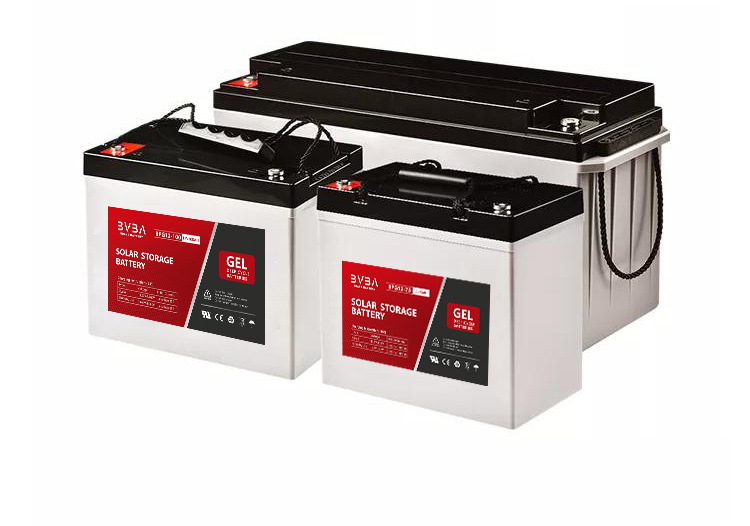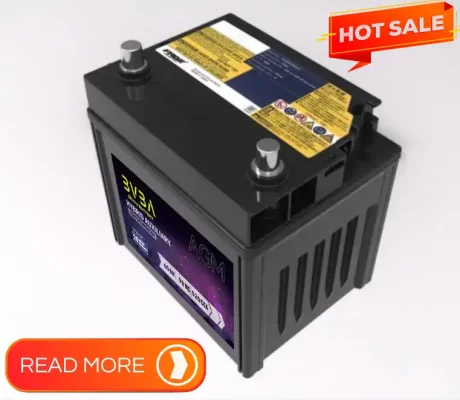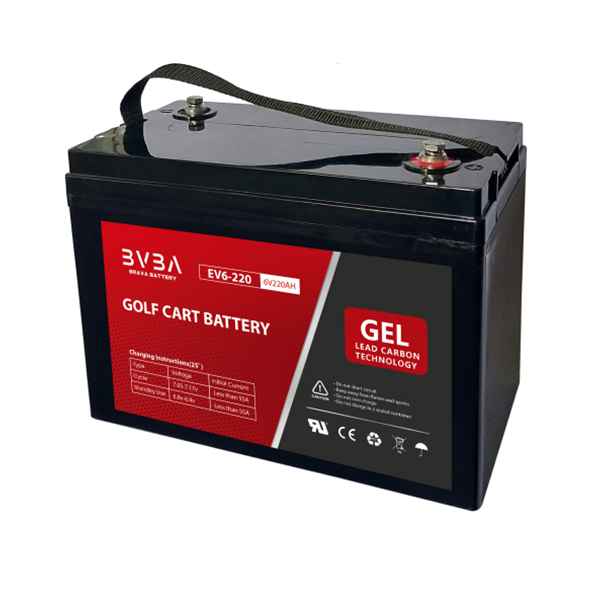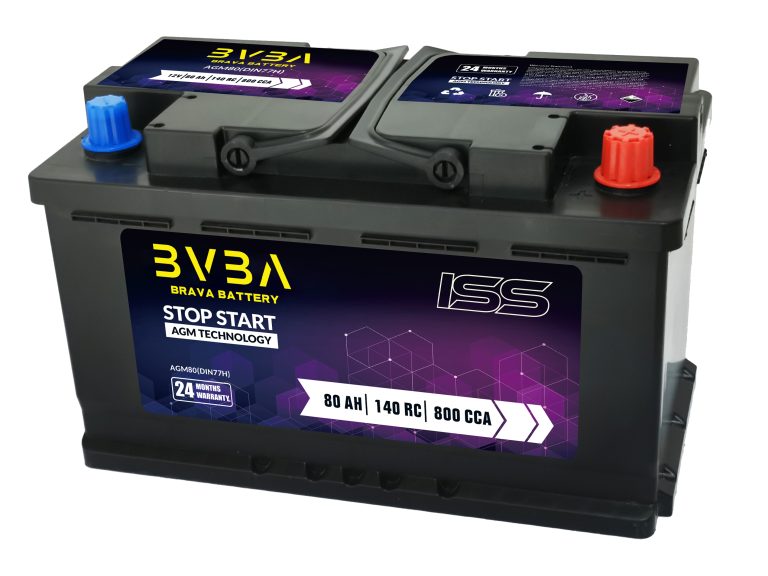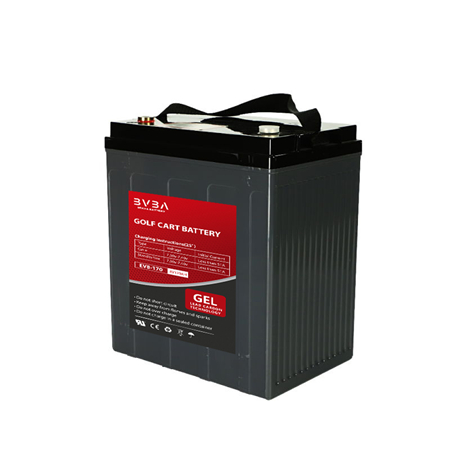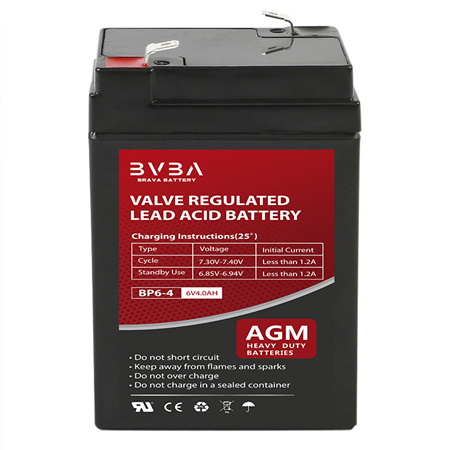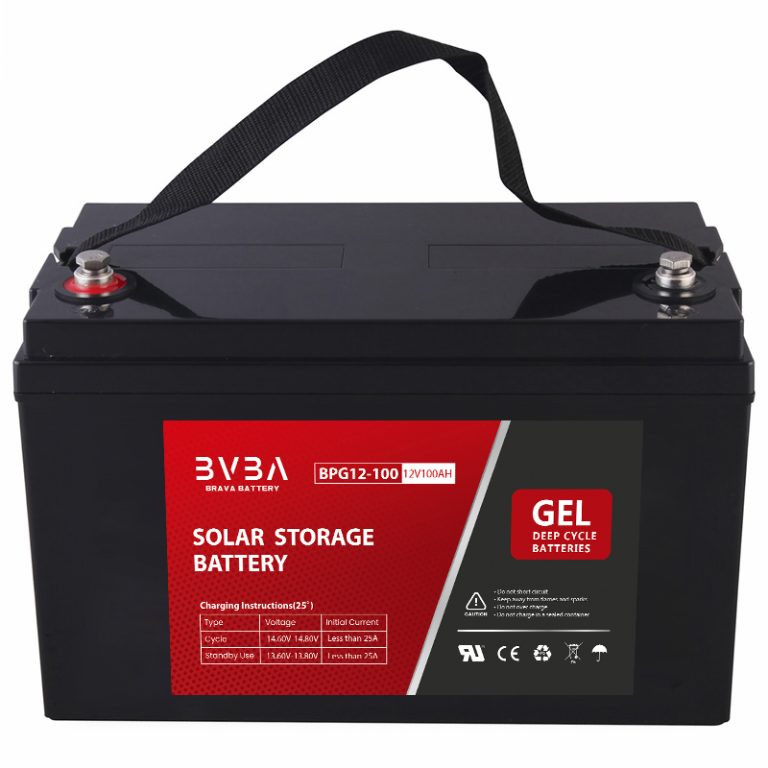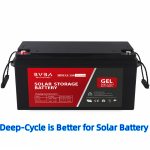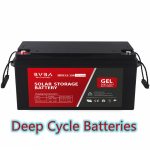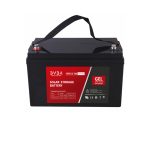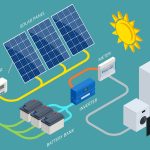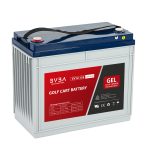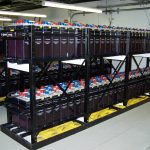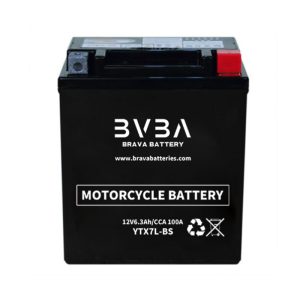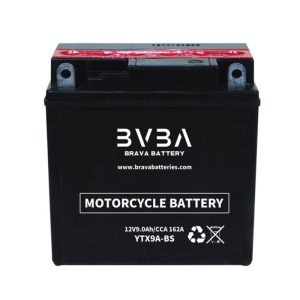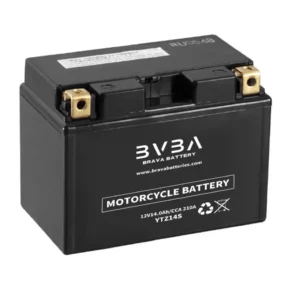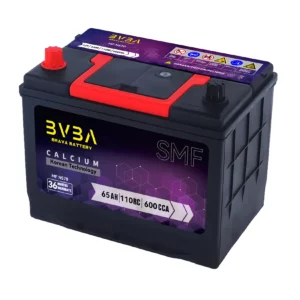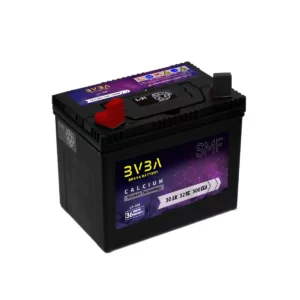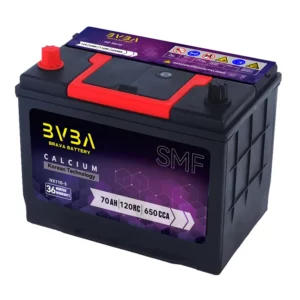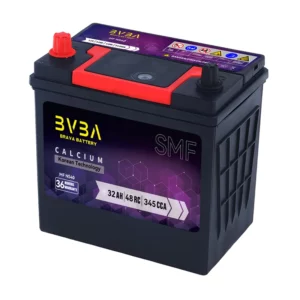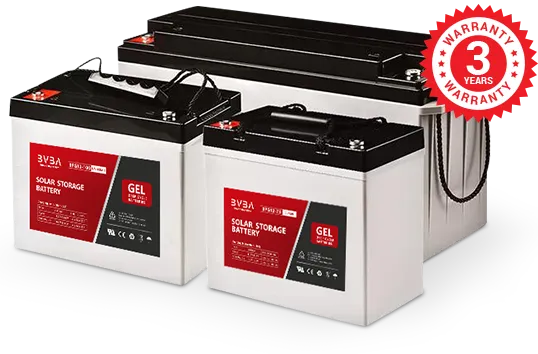Deep Cycle Batteries
When comparing quotes for different solar battery systems, it can be difficult to determine which characteristics and technical specifications matter most and with good reason: the home energy storage industry is so new that you probably don’t know anybody with a battery who you can ask about their experience. While every battery has to meet certain reliability and safety requirements in order to be sold and installed in the US, outside of those standards there is very little standardization of specs and characteristics across the batteries available on the market today. We’ve provided some tips on what to look for when comparing different battery quotes.
What is a solar battery?
A solar battery is a device that stores electricity for later use, so you can keep appliances running during a power outage, use more of the solar energy you produce at your home, and even save money on electricity in some cases. They are often referred to as “deep cycle batteries”, due to their ability to charge and discharge a significant amount of electricity compared to something like a car battery.
What to look for in a home solar battery: six measurements to consider
Energy storage systems provide a number of different benefits, from emergency backup power to even financial savings. But they also bring technical complexity and a new set of unfamiliar terminology. Here’s what to focus on and look for in a deep cycle solar battery:
How to decide which battery specs matter for your needs
There are a number of different potential decision criteria and comparison points to make when evaluating your energy storage options. Here are a few of the most common decision criteria, as well as which battery specs matter most if these criteria match your situation:
- If you want to power more of your home at once, look for a solar battery with a high power rating
- If you want to be able to power a more energy-intensive appliance (like a sump pump), look for a battery with a high instantaneous power rating
- If you want to run your home with your solar battery for a longer amount of time, look for a battery with a higher usable capacity
- If you want to get the most out of every kilowatt-hour of electricity you put into your battery, look for batteries with a higher roundtrip efficiency
- If you are space constrained and want to get the most amount of storage out of the least amount of space, look for lithium-ion nickel manganese cobalt (NMC) solar batteries
- If you want a battery with the longest lifetime that you can cycle the most amount of times, look for lithium iron phosphate (LFP) batteries
- If you want a battery with the absolute highest safety rating possible (don’t worry, they’re all safe!), look to LFP solar batteries
Power rating
The power rating of a battery refers to the kilowatts (kW) of power that the battery can provide at once. In other words, a battery’s power rating tells you both how many appliances your battery can power at once and which appliances those are.
Power is expressed either in kilowatts (thousands of Watts) or in Amps, and different appliances use different amounts of power. For instance, a typical compact fluorescent lightbulb will use 12 Watts (or 0.012 kW) of power, while a 3-ton AC unit will draw 20 Amps, which is equivalent to 4.8 kW. Most of the batteries available on the market today have a continuous power output of around 5 kW.
Importantly, solar batteries often have two different power ratings–a continuous power rating and a 5-minute or instantaneous power rating–meaning they can provide more power in short bursts. This is important if you have an appliance like a sump pump that requires a large amount of power to turn on, but then runs at lower power.
Battery size/usable storage capacity
A battery’s capacity (or size) is the amount of electricity that a battery is able to store and supply to your home. While power is expressed in kW, battery size is expressed in kilowatt-hours (kWh), which is power multiplied by time. As a result, a battery’s storage capacity tells you how long your battery can power parts of your home. Be sure to look for the usable capacity of a battery, as that number represents the amount of stored electricity that you can actually access in a battery.
Since electricity usage is power multiplied by time, if you are using more power, then you’ll run out of stored electricity faster. Conversely, if you’re only using your battery to backup a few appliances with relatively small power consumption, you can keep them running for a longer amount of time. This makes the size of a battery slightly misleading, because the length of time a battery’s charge will last is directly influenced by how much power it’s outputting.
Think about the example above of the difference between a light bulb and an AC unit. If you have a 5 kW, 10 kWh battery, you can only run your AC unit for two hours (4.8 kW * 2 hours = 9.6 kWh). However, that same battery would be able to keep 20 lightbulbs on for 2 full days (0.012 kW * 20 lightbulbs * 42 hours = 10 kWh).
How many solar batteries do you need to power your home?
Depending on what you want to use your energy storage system for and the characteristics of your household appliances, the number of batteries you’ll need can vary widely. There are several questions to answer: how long you’ll want to stay battery powered, what kind of production your solar panels get, what appliances you absolutely need to keep on, and the list goes on and on.
While we can’t say for certain how many batteries you’ll need, we’ve outlined the steps you can take to start doing that math in our article about how much of your house you can power on batteries. You can also check out our article on going off-grid with solar and batteries, where we do some example math on what it would take to keep your home completely solar and battery powered.
Roundtrip efficiency
Roundtrip efficiency is a system-level metric that measures how well your energy storage system (battery + inverter) converts and stores electricity. There are losses associated with any electrical process, meaning you’ll lose some kWh of electricity when you invert it from direct current (DC) electricity to alternating current (AC) electricity, or when you put electricity into a battery and take it out again. A solar battery’s roundtrip efficiency tells you how many units of electricity you’ll get out of a battery for every unit of electricity you put into it.
Battery lifetime: throughput and cycles
Battery lifetimes are measured with three different metrics: expected years of operation, expected throughput and expected cycles. A battery’s expected throughput and cycles are like a car’s mileage warranty. Throughput lets you compare how much electricity you’ll be able to move through your battery over its lifetime. Cycles measure how many times you can charge and discharge a battery.
To convert a battery’s expected or warranted throughput into an expected lifespan, divide the throughput (expressed in kWh) by the usable capacity of the battery to estimate how many full cycles you’ll get from your battery, and divide that number of full cycles by the number of days in the year: a 20,000 kWh throughput warranty on a 10 kWh battery means 2,000 expected cycles, or a cycle per day for 5.5 years.
To convert a battery’s expected or warranted number of cycles into an expected lifespan, divide the number of cycles by the number of days per year: a 4,000 cycle warranty equates to a cycle per day for 11 years.
Safety
All solar batteries have to meet certain safety requirements in order to be certified for installation in homes and businesses: every battery that you receive a quote for on EnergySage is safe and meets these safety requirements! There are, however, some battery chemistries that have been tested for safety to different levels, going even beyond the government-mandated safety requirements for batteries, meaning some battery chemistries are slightly safer than others. But the most important thing to remember is that all batteries installed in the US are very safe!
Chemistry
A battery’s chemistry refers to the primary compound that’s used to store electricity inside the battery. Chemistry may be the most important characteristic to compare since it ultimately determines a lot of the characteristics of batteries listed above. For instance, different lithium ion chemistries may be more power dense–meaning they store more electricity in a smaller amount of space–or may do a better job of cycling–meaning they are able to perform at a higher level for more years. And those are just the differences within lithium-ion chemistries, to say nothing of the differences between lithium ion batteries and lead acid batteries, or vanadium flow batteries, or other experimental battery chemistries. As is the case with most things, different solar battery chemistries come at (often significantly) different price points.
What is the best solar battery?
It’s hard to say. The best battery for you will depend on a number of factors, from the size of your home to the characteristics of your solar installation, and all the way to what you even want to get from an energy storage system. If you have a large home with lots of appliances, you’ll want to look for a high-capacity battery that can keep pumping out electricity for hours on end. If you’re price-conscious and care more about optimizing your solar energy system, a smaller battery with great battery integration may be the best choice.
Question / Answer
What type of batteries are best for solar power?
Deep cycle batteries are the recommended batteries to use in solar installations. There are a range of different deep cycle batteries, including flooded lead acid, sealed lead acid, and lithium iron batteries. Flooded lead acid batteries are the most inexpensive option and are available at most big-box and auto stores. They are also the most high maintenance. Sealed lead acid batteries store 10 to 15 percent more energy than lead acid batteries and charge up to four times faster. Lithium iron batteries are the most expensive options, but also last four times longer than lead-acid batteries, weigh much less, and require minimal maintenance. Deep cycle batteries are also available in a variety of voltage battery (12v, 24v, 48v).
Can I wire different battery types and sizes together?
We recommend wiring batteries of the same type and amp hour rating in your solar installation, i.e. if you go with absorbed glass mat batteries, all the batteries in your solar battery bank should be AGM batteries. This will limit any efficiency loss due to having different batteries.
How long does it take to charge a 12v 100ah battery?
Sunlight, temperature, and battery type will influence specific charging times. To get a general idea, you’ll need to calculate amps delivered from your solar panels (total wattage/voltage of your battery). Then you’ll divide the amp hours of your solar battery by amps delivered. For example, if you have a 100ah 12v battery with three 100 watt solar panels, your system would deliver 25 amps. By dividing 100Ah by 25 amps, you’ll learn it will take four hours for a 300 watt solar panel system to charge a 12v 100ah battery.
What is a deep cycle battery?
A deep-cycle battery is a battery designed to be regularly deeply discharged using most of its capacity. In contrast to car batteries which only provide short bursts of energy, deep cycle batteries are designed to provide sustained period over a longer period of time. The mainstream battery types in solar battery backup systems include Flooded Lead Acid (FLA) batteries, Gel batteries, Absorbed Glass Mat (AGM) batteries and lithium batteries. Depending on the voltage, deep cycle batteries are divided into 12v battery, 24v battery, and 48v battery. The most common deep cycle RV battery and marine deep cycle batteries are 12V, and the deep cycle golf cart batteries are normally 24V or 48V.
How to charge a deep cycle battery?
A charge controller is an essential piece of equipment for all solar battery storage systems. The right charger will help your battery charge faster. For example, lithium batteries can take a higher current, and they charge much faster than other types only when paired with the correct charger. Charge controller can also prevent the battery from charging over 100%. Once the battery is nearing full charge, the controller slows the amount of electricity flowing to the battery. When the batteries aren’t otherwise being used, the charge controller can “float” charge the battery for solar systems, or continuously top off the charge to prevent the battery from dying. Charge controllers come in different amp sizes and power tracking technologies, like PWM (Pulse Width Modulation) or MPPT (Maximum Power Point Tracking). You can find all types of top-ranking charge controllers at Renogy.
PWM Controllers: PWM charge controllers feature Pulse Width Modulation charging technology. PWM controllers are more basic in the sense that they drop the voltage coming from the solar panel(s) to the batteries. This drop in voltage equates to a loss in wattage, which results in 75-80% charging efficiency.
MPPT Controllers: MPPT controllers feature Maximum Power Point Tracking Technology. MPPT technology “finds” the maximum operating point for the panels’ current and voltage under any given condition. With this method, MPPT controllers are actually 94-99% efficient. This higher efficiency can help increase the life of the battery or battery bank you are using.
How long do deep cycle batteries last?
The lifespan of a deep cycle battery varies by battery types. Normally, AGM batteries lasts about 4-7 years; Gel Cell batteries lasts about 2-5 years; Flooded Lead Acid batteries lasts 4-8 years, and a high quality Lithium battery can last more than 10 years. The lifespan of a deep cycle battery also effected by battery cycles, maintenance, and the environment in which the battery is kept. For example, a Lead-acid battery’s cycle life can range from 500 to 1200, and a lithium battery can range from 2000 to more than 5000. Besides, a battery kept in a hot environment will experience a shorter lifespan than that in a cooler environment. The lifespan of marine batteries, RV batteries and boat batteries also depends on its usage scenario.
How to tell if a deep cycle battery is bad?
The symptoms of a bad deep cycle battery show when the battery fails to maintain a charge, or shows sluggish performance, or has shorter run times. Or you can tell your battery is bad by finding things like a damaged terminal, bulge or bump in the case, crack or rupture of the plastic, excessive leaking, or discoloration. Terminals that are broken or loose might can cause a short circuit. When a battery short circuits, all the power is unloaded instantly, generating a lot of heat and can potentially cause the battery to explode. Also, cracks, splits, and holes may not cause a battery to stop working, but the battery should be labeled unsafe for safety reasons. If a physical check reveals nothing, try measuring the battery voltage. Make sure it is fully charged before carrying out a voltage check on it, and give it to rest for 3-5 hours. You can use a multimeter to measure your batter’s electrical value. As a well-functioning 12V deep cycle battery is fully charged, its voltage should range from 12.7V to 13.2V. If the voltage reading shows 0, it indicates a short circuit and a dead battery. If the voltage is below 10.5 volts, your battery has to be replaced. If the test reads 12.4 volts or less, but your charger indicates a fully charged battery, it means the 12 volt deep cycle battery is sulfated and will require replacement.
What are deep cycle batteries used for?
Brava provides deep cycle batteries for solar systems that can meet various scenarios. Add the stable, long-lasting, and compact deep cycle RV batteries to your camper, keep your adventure empowered and stay comfortable and safe on your journey. Upgrading your boat to the reliable Brava deep cycle boat batteries, enjoy more energy but only at a fraction of the weight of a traditional lead-acid battery. Enjoy more fun of being on the water, no need to worry about your deep cycle marine batteries running low after a long day of use. Brava also provides the 24v battery and 48v deep cycle battery. Use the 48 volt golf cart batteries to increase your cart’s range, top speed, and acceleration, while saving space and weight.
Go to the product: gel batteries
Tag in this article: #Deep-cycle Battery
Tips: more detail information, for deep cycle batteries.

